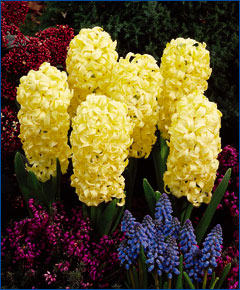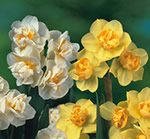Article for October 14, 2006
 In the field of horticulture, there is a season for everything. In San Antonio, the months of late September through early December are the prime times to purchase and plant fall bulbs for spring flowering color. Fall bulb varieties include tulips, daffodils, hyacinths, and crocus. The reward of planting in the fall will certainly be evident next spring when your landscape is adorned with an array of COLORFUL BLOOMS!
In the field of horticulture, there is a season for everything. In San Antonio, the months of late September through early December are the prime times to purchase and plant fall bulbs for spring flowering color. Fall bulb varieties include tulips, daffodils, hyacinths, and crocus. The reward of planting in the fall will certainly be evident next spring when your landscape is adorned with an array of COLORFUL BLOOMS!
For a fall bulb to develop normally and produce the best flower in the spring, it must begin producing roots from the bulb during the cold winter months. Then as spring comes and soils warm up, the bulb produces foliage. This foliage is supported by the good root system that developed during the winter. The root system and the foliage provide support for a good flower development.
 If you plant your bulbs too early, the soil will be too warm, and the tops will begin to sprout. In this case, the bulbs have to produce both tops and roots at the same time. This division of energy use usually results in a smaller root system and less foliage. In addition, foliage could freeze back during some of our really cold spells in the winter. The loss of foliage further reduces the ability of bulbs to produce and support showy bloom in the spring. HOWEVER, fall bulbs that flower in the spring should be purchased NOW during the months of September and October while the selection is at its best.
If you plant your bulbs too early, the soil will be too warm, and the tops will begin to sprout. In this case, the bulbs have to produce both tops and roots at the same time. This division of energy use usually results in a smaller root system and less foliage. In addition, foliage could freeze back during some of our really cold spells in the winter. The loss of foliage further reduces the ability of bulbs to produce and support showy bloom in the spring. HOWEVER, fall bulbs that flower in the spring should be purchased NOW during the months of September and October while the selection is at its best.
In comparison, if you plant your bulbs too late, like in January or February, the bulbs do not have enough time to produce a good strong root system before spring. Consequently during the spring, your bulbs will not only be using energy to produce a root system, but foliage and blooms all at the same time. Your bulbs will not have enough energy to do all three at the same time, so consequently the flowers, the roots, and the foliage will be small and puny.
When planting your bulbs there are some rules of thumb that you can use to increase the chances of being successful and producing a great show of blooms next spring.
First, plant your bulbs at a depth of twice the diameter of the bulb. Second, plant your bulbs no further apart than the diameter of the bulbs. Masses of bulbs in a small area produce large shows of color. If you plant your bulbs further apart (six inches for example), you will probably get great flower blooms, with bulbs that have a good root system, but from a distance, the “SHOW” will not be impressive. A lot of bulbs in a small area will get you the show that you come to expect from planting fall bulbs.
Before planting, make sure to work liberal amounts of peat moss, or other organic material like compost, into the soil of the planting bed. Bulbs do not do well in tight clay soils, so consider planting in raised beds that contain amended soil. Mixing peat or compost into the soil will help break up the clay and make it more friable.
Make sure to place a handful of bone & blood meal under each bulb. Bone meal is very high in phosphorous, a nutrient known to encourage root development. Blood meal provides a good amount of slow released nitrogen. Remember that for bulbs to do well, they must establish a good root system before tops and flowers develop.
If you have trouble with “critters” eating your bulbs in the winter, dust your bulbs with powdered sulfur or soak the bulbs in an animal repellant product. Either will discourage squirrels and other varmints from digging up your precious bulbs.
Finally after planting, be sure to water the planting bed and deliver enough water to make the soil soggy. This watering will eliminate air pockets which are often formed in the soil during the planting process, thus resulting in a better root development. You may also mulch the planting bed if you so desire. Consider using a cedar or cypress mulch to a depth of two to four inches. Organic or living mulches will help the soil hold moisture. As you know, we often have dry winters, so it’s important to keep the soil around bulbs moist in the winter when roots are developing.
Remember, Learn and Have Fun!
David Rodriguez is the County Extension Agent-Horticulture for Bexar County. He represents Texas Cooperative Extension with the Texas A&M University System. For any landscape or gardening information, call the Bexar County Master Gardeners Hotline at (210) 467-6575, e-mail questions to mg-bexar@tamu.edu, or visit our County Extension website at http://bexar-tx.tamu.edu/.
Special Note: Listen live broadcast of the Home & Garden Show with David Rodriguez and Bill Rohde on WOAI 1200 AM, every Saturday morning, between 8:00-11:00 a.m., and call in your gardening questions at (210/737-1200 or 1-800-383-9624).
Check it out!